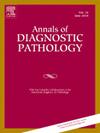胃肠活检双片连续切片的评价:分析1715例,重点分析临床影响。
IF 1.4
4区 医学
Q3 PATHOLOGY
引用次数: 0
摘要
虽然连续切片可以提高诊断率,但目前还没有内镜下胃肠道活检的标准化方案。本研究的目的是确定检查每个活检标本的两个连续切片切片是否增加了临床相关组织病理学发现的检测。在这项前瞻性研究中,使用两张切片连续切片方法对1715例内镜下胃肠道活检标本进行评估,每张切片连续切片8张。诊断差异被定义为在一张载玻片上存在组织病理学发现,而在另一张载玻片上不存在,从而代表了检测的不同载玻片。无论患者身份如何,每个活检标本都被视为一个单独的病例,用于连续切片和诊断评估,因为研究的重点是每个样本的诊断变异性。在2.2%的病例中发现载玻片之间的诊断差异,其中1.4%被认为具有临床意义。这包括第二张幻灯片上的额外发现的增加和只出现在第一张幻灯片上的发现的减少。肠化生是最常见的临床相关发现,特别是在胃窦活检中。重要的是,在第二张载玻片上没有发现其他恶性肿瘤,活检相关变量也没有显示出与诊断差异的显著关联。总的来说,这些发现表明,虽然不常见,但由连续切片引起的诊断差异可能具有重要的临床意义,特别是在检测肿瘤前病变(如胃窦肠化生)时。本文章由计算机程序翻译,如有差异,请以英文原文为准。
Evaluation of gastrointestinal biopsies with two-slide serial sections: Analysis of 1715 cases with emphasis on clinical impact
Although serial sectioning may improve diagnostic yield, no standardized protocol currently exists for endoscopic gastrointestinal (GI) biopsies. The aim of this study was to determine whether examining two serially sectioned slides from each biopsy specimen increases the detection of clinically relevant histopathological findings. In this prospective study, 1715 endoscopic GI biopsy specimens were evaluated using a two-slide serial sectioning approach, with eight consecutive sections per slide. A diagnostic discrepancy was defined as the presence of a histopathological finding on one slide that was absent on the other, thereby representing slide-to-slide variability in detection. Each biopsy specimen was treated as an individual case for serial sectioning and diagnostic assessment purposes, regardless of patient identity, as the study focused on per-sample diagnostic variability. Diagnostic discrepancies between slides were found in 2.2 % of cases, with 1.4 % deemed clinically significant. These included both gain of additional findings on the second slide and loss of findings that were present only on the first slide. Intestinal metaplasia was the most frequently observed clinically relevant finding, particularly in antral biopsies. Importantly, no additional malignancies were identified on second slides, and none of the biopsy-related variables showed a significant association with diagnostic discrepancies. Overall, these findings suggest that, while infrequent, diagnostic discrepancies introduced by serial sectioning may have meaningful clinical implications—particularly in detecting preneoplastic conditions such as intestinal metaplasia in the antrum.
求助全文
通过发布文献求助,成功后即可免费获取论文全文。
去求助
来源期刊
CiteScore
3.90
自引率
5.00%
发文量
149
审稿时长
26 days
期刊介绍:
A peer-reviewed journal devoted to the publication of articles dealing with traditional morphologic studies using standard diagnostic techniques and stressing clinicopathological correlations and scientific observation of relevance to the daily practice of pathology. Special features include pathologic-radiologic correlations and pathologic-cytologic correlations.

 求助内容:
求助内容: 应助结果提醒方式:
应助结果提醒方式:


